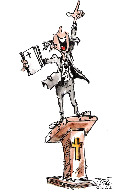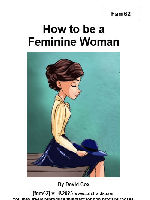DID THEY DIP? ..OR.. (Baptism)
AN EXAMINATION INTO THE ACT OF BAPTISM AS PRACTICED BY THE ENGLISH AND AMERICAN BAPTISTS BEFORE THE YEAR 1641.
BY JOHN T. CHRISTIAN, M. A., D. D.,
Pastor EAST BAPTIST CHURCH, LOUISVILLE, KY.,
In this 12 chapter work by John Christian (Baptist), he presents us with the case of Baptist Baptism was never by immersion until after 1644. His chapters are statement of the case, anabaptists of England, immersion in England, anabaptists of the continent, John Smyth, the Baptists of 1641, English Baptists before 1641, the Kiffin Ms. and the Jessey Church Records, Some Witnesses, a Challenge accepted, and Roger Williams.

Stalker The Preacher and His Models Looks at the Preacher as a Man of God, a Patriot, a man of the Word, as a False Prophet, as a man, as a Christian, as an Apostle, and as a Thinker.
Read the Work: Stalker The Preacher and His Models.
CONTENTS
INTRODUCTION
1. A Statement of the Case
2. The Anabaptists of England
3. Immersion in England
4. The Anabaptists of the Continent
5. John Smyth
6. The Baptists of 1641
7. The English Baptists Before 1641
8. The Kiffin Ms. And the Jessey Church Records
9. Some Witnesses
10. Other Witnesses
11. A Challenge Accepted
12. Roger Williams
Download
Christian, J.T. - Did they Dip? (104 downloads )INTRODUCTION.
R. CHRISTIAN has shown a remarkable talent for gathering and arraying authorities. For more than twenty years he has been studying the history of immersion and has spared no time nor expense to supply himself with original documents. I do not suppose there is a Baptist in the land who has anything like such an array of original documents on this subject as has Dr. Christian. In many cases he has the original editions, while in others he has official copies made at the British museum and elsewhere. He has examined more than forty books which. Dr. Dexter-does not mention in his bibliography of the subject, and which, it is reasonable to believe, Dr. Dexter never saw.
Dr. Christian is also singularly accurate in his use of authorities. I have read this book through and have not detected a single inaccuracy. Many of the quotations I have personally verified and have found them correct, and though I have not verified them all, yet I have no doubt of the absolute correctness of every one. He courts investigation, however, and he will gladly welcome the detection of any mistake in the book. The most unpleasant thing in connection with replying to Dr. Whitsitt’s “Question in Baptist History” is calling attention to his unauthorized use of documents, owing largely to his misplaced confidence in Dr. Dexter. And yet whoever replies to any book must needs call attention to its misuse of authorities where such misuse exists. When, for example, such great stress is laid on the supposed testimony of the “Jessey Church Records,” it is needful in replying to point out that what is quoted as “Jessey Church Records” really belongs to an “ancient manuscript said to have been written by Mr. William Kiffin.” In all this Dr. Christian has not gone beyond the limits of honorable controversy. Indeed he is not so severe on Dr. Whitsitt as the latter is on Dr. Clifford. When a man enters the lists of controversy he must expect his statements to be challenged.
It should be constantly borne in mind that not till the year 1641 were the Baptists in England free to speak and write their views. It was on August 1, 1641, that the Court of High Commission and the Court of Star Chamber went out of existence. Then, and not till then, could Baptists come from their hiding places and preach openly. Of course, their doctrines and practices were new to a great many people. To find instances, therefore, after 1641, where Baptists were called “new” does not at all prove that they began to exist in 1641. Indeed, the fact that they were then heard from so vigorously, and spread so rapidly, itself proves they were in existence, though in hiding, before. Just so soon as it was safe for them to show themselves they are seen here, there and everywhere, to the great annoyance of the state clergy, who call them “new, upstart sectaries,” etc. The fact that in 1644 immersion had such a strong hold on the divines composing the Westminster Assembly that after a long and bitter debate they voted it down by only one majority is decisive proof that immersion did not begin in England in 1641.
Then Dr. Joseph Angus, our Great British scholar, has called attention to a number of Baptist Churches in England which trace their history to times long before 1641, e. g., Braintree, Eythorne, Sutton, Warrington, Bridgewater, Oxford and Sadmore. All the Baptists of England, so far as I know, believe that their fathers practiced immersion before 1641.
Dr. Whitsitt’s contention is that from 1509 to 1641 the Anabaptists of England practiced affusion, and in that year they began to practice immersion. And yet he has not cited a single instance where any Anabaptists in England practiced affusion, not a single case where any Anabaptist Church adopted immersion. The “Jessey Church” was not an Anabaptist Church, and an anonymous manuscript which has been lost, and whose date nobody knows, is the only evidence that this church began to practice immersion. Richard Blount is said to have gone over to Holland to get baptism in the true succession, and to have returned and baptized Blacklock, yet neither Blount nor Blacklock show themselves afterwards. When in 1644 the Baptists of London put forth their Confession of Faith, the names of Blount and Blacklock are significantly absent from the list of signatures.
While before 1641 in England Baptists were obliged to hide and to speak with bated breath, yet we are not left in the dark concerning their practices. Outsiders told of them, and so we have direct testimony concerning them. Dr. Christian gives a good deal of this, and if any of it at all be valid Dr. Whitsitt’s thesis is overthrown. Take for example John Fox’s testimony in his Book of Martyrs, published in 1562:
There are some Anabaptists at this time in England who came from Germany. Of these there were two sorts; the first only objected to the baptising of children and to the manner of it by sprinkling instead of dipping. The other held many opinions anciently condemned as heresies; they had raised a war in Germany, and had set up a new king in Munster; but all these were called Anabaptists, from their opposition to infant baptism, though it was one of the mildest opinions they held.—Fox’s Book of Martyrs, Alden ed., p. 338.
Thus it appears that both sorts of Anabaptists opposed infant baptism and sprinkling, but the first class “only objected to “these things, while the second class in addition to that “held many opinions anciently condemned as heresies.” Fox’s Book of Martyrs has long been an English classic; and no one has impeached its truthfulness. What motive could Fox have had for misrepresentation; and what possible reason exists for impeaching his testimony? . And yet his testimony has got to be entirely set aside, or else Dr. Whitsitt’s thesis falls. Ten thousand men saying after 1641 that immersion was “new” to them would not offset John Fox’s testimony that he knew of immersion in England in 1562. But Fox is only one of many.
One great good to come from this discussion is that Baptists will be better informed in regard to their history than ever before. Whatever may be the final outcome of the controversy, it must be admitted that Dr. Whitsitt has stirred up the Baptists in regard to their history as nobody else has ever done, and as nobody else is likely ever to do. Of all people, the Baptists are the last to be afraid of the truth on any subject.
T. T. EATON.
LOUISVILLE, KY., October 22, 1896.
And Author of Immersion, the Act of Baptism,” “Close Communion; or, Baptism as a Prerequisite to the Lord’s Supper,” “Americanism or Romanism, Which?” “Four Theories of Church Government,” “Heathen and Infidel Testimonies to Jesus Christ,” etc.
WITH AN INTRODUCTION
BY T. T. EATON, D. D., LL. D.,
More Works on Baptism
- Unknown Acts 2 and the Purpose of Baptism
- Ironside, H.A. – Baptism: What Saith the Scripture?
- Gill Proper Mode of Baptism
- Fitzwater, P.B. – Christian Theology
- Dagg Manual of Theology
- Christian, J.T. – Did they Dip? (Baptism)
- Chafer – Major Bible Themes
- Binney-Steele – Theological Compend
- Bellett Paul’s Apostleship and Epistles
- Baier, J. – Compendium of Positive Theology

fam62 How to be a Feminine Woman examines femininity from a Bible perspective. It compares homosexuals being feminine. Topics: God created us, man, and woman. | The Spiritual Fight is within us ourselves. | A Device of Satan A Device of Satan | The Homosexual and Trans Angle | Highlighting the Woman, How She Behaves | The Crux of the Matter | To Be a Feminine Woman, She must attend to her adorning. | The Description of a Woman.
Excerpt from the Tract: 1 Corinthians 6:9 Know ye not that the unrighteous shall not inherit the kingdom of God? Be not deceived: neither… nor adulterers, nor effeminate… In other words, these people were doing the opposite of what God commanded them to do. Being men and having the command to act manly (1 Corinthians 16:13 Watch ye, stand fast in the faith, quit you like men, be strong), they acted like women. For women, it is the command of God that they act feminine, to be womanly. To seem feminine, these perverts usually use a dress or skirt, and they never use pants, because they know that by using pants they identify themselves being masculine, and using skirts and dress with being feminine. But it seems like an impossible thing to fathom, but even homosexuals know exactly how to identify as a woman, men being feminine, in their rebellion, and Christian women can neither define what it is that God commands them to be, how to dress themselves as women, neither how to act feminine.
How do you distinguish between a man and a woman? Pants in a man, and dress or skirt in a woman. Even common bathroom signs show this obvious point. The question is not how a woman dress should, but why don’t women, especially Christian women, dress like a woman should. It is not a matter of clarity, but a matter of no desire on the part of certain women. Are you a feminine woman? If not, why not?
Read the Tract: fam62 How to be a Feminine Woman
MySwordmodules is a website dedicate to the MySword Bible Program for Androird devices. We host MySword Modules.

Buy me a piece of Mexican SweetBread!
Everybody likes sweet bread. In Mexico, it is a tradition to eat this sweetbread with coffee or hot chocolate before going to bed. But alas, while you are also enjoying the delicious stuff from my websites, I am out of money. A gift of any amount will at least let us buy a piece of sweetbread.
Please donate something for the upkeep of this website. I am bearing the burden of the monthly upkeep for years now, and I only have a few donations PER YEAR out of all of my websites, and that only like $25 dollars each time.

